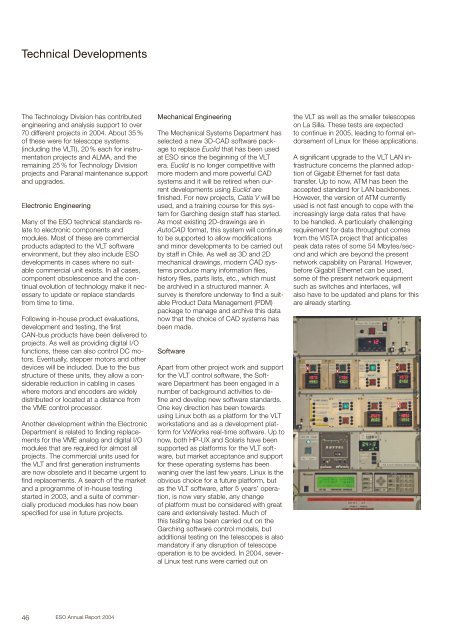ESO Annual Report 2004
ESO Annual Report 2004
ESO Annual Report 2004
- TAGS
- annual
- www.eso.org
Create successful ePaper yourself
Turn your PDF publications into a flip-book with our unique Google optimized e-Paper software.
Technical Developments<br />
The Technology Division has contributed<br />
engineering and analysis support to over<br />
70 different projects in <strong>2004</strong>. About 35 %<br />
of these were for telescope systems<br />
(including the VLTI), 20 % each for instrumentation<br />
projects and ALMA, and the<br />
remaining 25 % for Technology Division<br />
projects and Paranal maintenance support<br />
and upgrades.<br />
Electronic Engineering<br />
Many of the <strong>ESO</strong> technical standards relate<br />
to electronic components and<br />
modules. Most of these are commercial<br />
products adapted to the VLT software<br />
environment, but they also include <strong>ESO</strong><br />
developments in cases where no suitable<br />
commercial unit exists. In all cases,<br />
component obsolescence and the continual<br />
evolution of technology make it necessary<br />
to update or replace standards<br />
from time to time.<br />
Following in-house product evaluations,<br />
development and testing, the first<br />
CAN-bus products have been delivered to<br />
projects. As well as providing digital I/O<br />
functions, these can also control DC motors.<br />
Eventually, stepper motors and other<br />
devices will be included. Due to the bus<br />
structure of these units, they allow a considerable<br />
reduction in cabling in cases<br />
where motors and encoders are widely<br />
distributed or located at a distance from<br />
the VME control processor.<br />
Another development within the Electronic<br />
Department is related to finding replacements<br />
for the VME analog and digital I/O<br />
modules that are required for almost all<br />
projects. The commercial units used for<br />
the VLT and first generation instruments<br />
are now obsolete and it became urgent to<br />
find replacements. A search of the market<br />
and a programme of in-house testing<br />
started in 2003, and a suite of commercially<br />
produced modules has now been<br />
specified for use in future projects.<br />
46<br />
<strong>ESO</strong> <strong>Annual</strong> <strong>Report</strong> <strong>2004</strong><br />
Mechanical Engineering<br />
The Mechanical Systems Department has<br />
selected a new 3D-CAD software package<br />
to replace Euclid that has been used<br />
at <strong>ESO</strong> since the beginning of the VLT<br />
era. Euclid is no longer competitive with<br />
more modern and more powerful CAD<br />
systems and it will be retired when current<br />
developments using Euclid are<br />
finished. For new projects, Catia V will be<br />
used, and a training course for this system<br />
for Garching design staff has started.<br />
As most existing 2D-drawings are in<br />
AutoCAD format, this system will continue<br />
to be supported to allow modifications<br />
and minor developments to be carried out<br />
by staff in Chile. As well as 3D and 2D<br />
mechanical drawings, modern CAD systems<br />
produce many information files,<br />
history files, parts lists, etc., which must<br />
be archived in a structured manner. A<br />
survey is therefore underway to find a suitable<br />
Product Data Management (PDM)<br />
package to manage and archive this data<br />
now that the choice of CAD systems has<br />
been made.<br />
Software<br />
Apart from other project work and support<br />
for the VLT control software, the Software<br />
Department has been engaged in a<br />
number of background activities to define<br />
and develop new software standards.<br />
One key direction has been towards<br />
using Linux both as a platform for the VLT<br />
workstations and as a development platform<br />
for VxWorks real-time software. Up to<br />
now, both HP-UX and Solaris have been<br />
supported as platforms for the VLT software,<br />
but market acceptance and support<br />
for these operating systems has been<br />
waning over the last few years. Linux is the<br />
obvious choice for a future platform, but<br />
as the VLT software, after 5 years’ operation,<br />
is now very stable, any change<br />
of platform must be considered with great<br />
care and extensively tested. Much of<br />
this testing has been carried out on the<br />
Garching software control models, but<br />
additional testing on the telescopes is also<br />
mandatory if any disruption of telescope<br />
operation is to be avoided. In <strong>2004</strong>, several<br />
Linux test runs were carried out on<br />
the VLT as well as the smaller telescopes<br />
on La Silla. These tests are expected<br />
to continue in 2005, leading to formal endorsement<br />
of Linux for these applications.<br />
A significant upgrade to the VLT LAN infrastructure<br />
concerns the planned adoption<br />
of Gigabit Ethernet for fast data<br />
transfer. Up to now, ATM has been the<br />
accepted standard for LAN backbones.<br />
However, the version of ATM currently<br />
used is not fast enough to cope with the<br />
increasingly large data rates that have<br />
to be handled. A particularly challenging<br />
requirement for data throughput comes<br />
from the VISTA project that anticipates<br />
peak data rates of some 54 Mbytes/second<br />
and which are beyond the present<br />
network capability on Paranal. However,<br />
before Gigabit Ethernet can be used,<br />
some of the present network equipment<br />
such as switches and interfaces, will<br />
also have to be updated and plans for this<br />
are already starting.

















